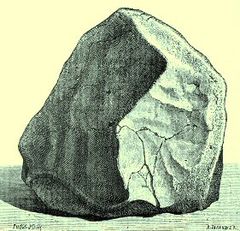Orgueil (meteorite)
| Orgueil | |
|---|---|
| Type | Chondrite |
| Class | Carbonaceous chondrite |
| Group | CI1 |
| Country | France |
| Region | Midi-Pyrénées |
| Coordinates | 43°53′N 1°23′E / 43.883°N 1.383°ECoordinates: 43°53′N 1°23′E / 43.883°N 1.383°E |
| Observed fall | Yes |
| Fall date | May 14, 1864 |
| TKW | 14 kg |
 Original painting of an individual fragment from the Orgueil meteorite |
|
Orgueil is a scientifically important carbonaceous chondrite meteorite that fell in southwestern France in 1864.
It fell on May 14, 1864, a few minutes after 20:00 local time, near Orgueil in southern France. About 20 stones fell over an area of several square miles. A specimen of the meteorite was analyzed that same year by François Stanislaus Clöez, professor of chemistry at the Musée d'Histoire Naturelle, who focused on the organic matter found in this meteorite. He wrote that it contained carbon, hydrogen, and oxygen, and its composition was very similar to peat from the Somme valley or to the lignite of Ringkohl near Kassel. An intense scientific discussion ensued, continuing into the 1870s, as to whether the organic matter might have a biological origin.
Orgueil is one of five known meteorites belonging to the CI chondrite group (see meteorites classification), this being the largest (14 kilograms (31 lb)). This group is remarkable for having a composition that is essentially identical to that of the sun, excluding gaseous elements like hydrogen and helium.
Because of its extraordinarily primitive composition and relatively large mass, Orgueil is one of the most-studied meteorites. One notable discovery in Orgueil was a high concentration of isotopically anomalous xenon called "xenon-HL". The carrier of this gas is extremely fine-grained diamond dust that is older than the solar system itself, known as presolar grains.
In 1962, Nagy et al. announced the discovery of 'organised elements' embedded in the Orgueil meteorite that were purportedly biological structures of extraterrestrial origin. These elements were subsequently shown to be either pollen (including that of ragwort) and fungal spores (Fitch & Anders, 1963) that had contaminated the sample, or crystals of the mineral olivine.
In 1965, a fragment of the Orgueil meteorite, kept in a sealed glass jar in Montauban since its discovery, was found to have a seed capsule embedded in it, whilst the original glassy layer on the outside remained apparently undisturbed. Despite great initial excitement, the seed capsule was shown to be that of a European rush, glued into the fragment and camouflaged using coal dust. The outer "fusion layer" was in fact glue. Whilst the perpetrator is unknown, it is thought that the hoax was aimed at influencing 19th century debate on spontaneous generation by demonstrating the transformation of inorganic to biological matter.
...
Wikipedia
